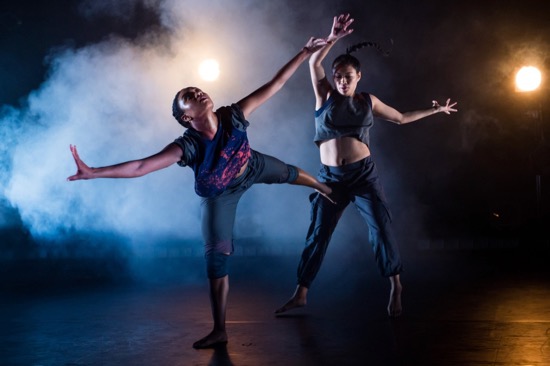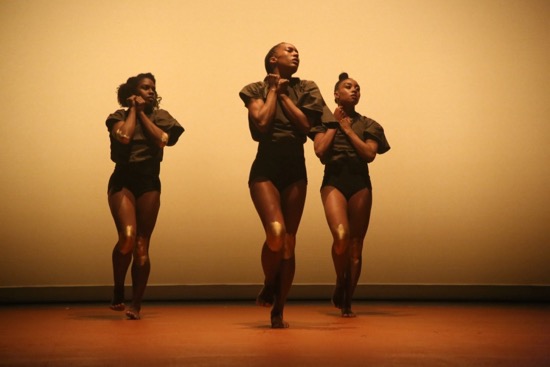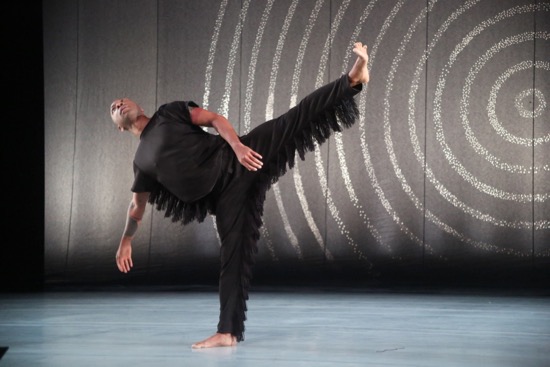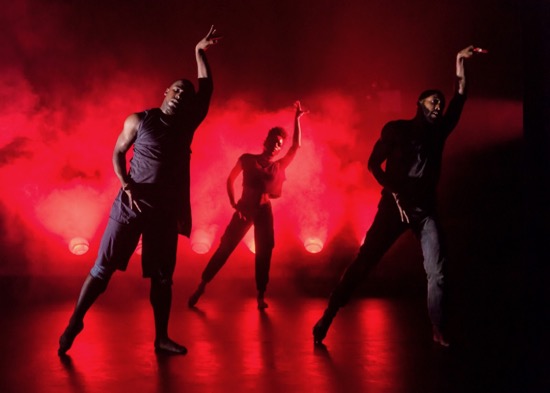Kyle Abraham’s company, A.I.M., performs at the Joyce Theater.

Marcella Lewis (L) and Keerati Jinakunwiphat in Kyle Abraham’s Drive. Photo: Ian Douglas
Kyle Abraham used to call his company Kyle Abraham/Abraham in Motion. Now it’s called A.I.M. Of course, if you want to visit the company’s website, you may find yourself at Associated International Management or Advanced Idea Mechanics, but I expect he knows that.
The concise new name minimizes his position, as well as hinting at an arrow aimed at a target (an idea I won’t try to develop). Another change: Three guest choreographers, Andrea Miller, Bebe Miller, and Doug Varone, contributed works to A.I.M.’s recent season at the Joyce, and those by Abraham are tagged as having been created “in collaboration with A.I.M.,” meaning with the dancers, but maybe also with contributors not seen onstage.
Bringing in other choreographers is one way to stimulate Abraham’s vivid performers and to show them in a new light. Andrea Miller’s state, a world premiere created in collaboration with the dancers, invites us to look at Kayla Farrish, Catherine Ellis Kirk, and Tamisha Guy as women warriors. We can’t identify them as such right away, because they’re in semi-darkness at the back of the stage, turned away from us and hunched over. Their small steps from side to side gradually quicken, straighten them up, and turn them to face us. They maintain a triangle, with Kirk center front, for quite a while.

Andrea Miller’s state. L to R: Kayla Farrish, Catherine Ellis Kirk, and Marcella Lewis. Photo: Steven Schreiber
Jose Solis’s handsome minimal costumes have big sleeves that augment the women’s shoulders. An oval of silver paint decorates each knee, and when they turn their palms away from us, we can see the white marks on their fingers and the backs of their hands that suggest the skeleton bones beneath the skin. Pearce’s lighting throws their shadows on the backdrop, and sighing voices and sucking sounds occasionally seep into Reggie Wilkins’s score.
Whoever these woman are, they function as a unit, even when they spread out into space or move individually. I called them warriors, but you’re unlikely to see some of their maneuvers in a real battle. They can sit curled up and hunch themselves across the floor. Or lie on their bellies and reach back to hold their ankles. They’re as striking suddenly arrested into stillness as they are moving powerfully.
I should probably refrain from linking INDY, the first solo that Abraham has made for himself in years, with the famous auto race, but it is a journey, and he starts out by defining a path that edges the stage. Abigail DeVille’s backdrop shows a delicate, monochromatic target, behind which something like a headlight later shines (lighting by Nicole Pearce). Abraham wears a remarkable garment by Karen Young: black pants and short-sleeved top, fringed like the buckskin outfits we’re told frontiersmen wore.

Kyle Abraham in his solo INDY. Photo: Steven Schreiber
Abraham is a marvelous mover, and whatever sources he draws from—ballet, modern dance, hip-hop, vogueing, memories, everyday life, and more—he stirs into something personal and unusual. At one point, just watching him walk, dropping his weight on one foot—not exactly lame, but not not either—sets you thinking. So does seeing his hands together behind his back or in his pockets. So does the way he drops down to scrub at the floor. He can move from lancelike precision into silkiness and slipperiness without apparent transition. His hips are mobile, his tread on the floor as soft as that of a big cat, although he can spin over its surface with the rapidity of a kite string unreeling.
Disturbances, crowd noises and the like creep into Jerome Begin’s score. Abraham hints at states of mind, mostly quite subtly, appearing shy and giggly for a moment. Suspending a step onto one foot, he is calm, happy. . .maybe just doing it makes him feel that way. But there’s more than a hint of anguish in INDY, and his ritualistic removal of his outer garments stirs other thoughts. At the end, he’s back on a straight path, advancing toward us, opening and closing his arms like slow wings.
Abraham has made some stunning works. Pavement comes to mind; so do Dearest Home and The Radio Show—works that dig into and slide along with and tear apart his own history as an African America man growing up in Pittsburgh and the ongoing history of racial prejudice in our country. All of these, he formalizes in ways that both avoid simple realism and deepen the pain. His new Meditation: A Silent Prayer, with music by Craig Harris is short and not as full as those mentioned above. But its cast of five women (the three in Miller’s state plus Keerati Jinakunwiphat and Marcella Lewis) and one man, Jeremy “Jae” Neal, eloquently fall and help one another up, perhaps have to pick someone off the floor. You hear a desperate recorded entreaty: “Please, officer!” Meditation: A Silent Prayer evokes oppression and victimization through projected faces and references to lost lives: Eric Garner, Trayvon Martin, Michael Brown. . . .and most powerfully through the recorded voice of multi-gifted artist Carrie Mae Weems, reciting an anonymous list of victims (“she was 20,” “he was 17,” “he was 33,” “she was 9”). The list is very, very, very long. And the dance seems cut short. Maybe there’s more to come.

(L to R): Claude “CJ” Johnson, Tamisha Guy, and Jeremy “Jae” Neal in Kyle Abraham’s Drive. Photo: Ian Douglas
Drive, which premiered as part of last year’s Fall for Dance Festival at City Center embeds images of unity, defiance, and loss in a world aflame. Dan Scully’s scenic and lighting design pours smoke onto the stage, and the atmosphere is afire at times, but also turns into the blue of night. The music of Theo Parrish and Mobb Deep builds from deep quiet to rhythms that have the push of house music and seem to incite action. Matthew Baker and Claude “CJ” Johnson join the dancers already mentioned to form an eight-person group. Which means that four can fight four, two can “converse,” everyone can dance. You don’t see a dramatic narrative develop; Drive is more like an essay or maybe a poem. If one person gets dragged away, he/she could be being saved, but the outcome might as easily be worse.
All hail the dancers of the evening—their heat, their skill, their spirit. The breaking news is that Abraham has been commissioned to choreograph a piece next season for the New York City Ballet’s very different dancers. I’m looking forward to it.
